Cham islands in Champa maritime space from 11th to 15th century
Situated in a critical position on the sea routes in Southeast Asia, the Cham Islands or Cu Lao
Cham (Vietnamese: Cù Lao Chàm) emerged remarkably as an important outport of the maritime
kingdom of Champa since the first centuries. Over many centuries, the region of the Cham Islands and
the estuary port of the Great Champa, also called Dai Chiem seaport (Vietnamese: Đại Chiêm hải khẩu
or Cửa Đại), not only was seen as a destination and a trade centre of the small state of Amaravati, but
also played a significant role in linking the kingdom of Champa with the outside world. In history, Cham
people actively integrated into the region and the world, contributing greatly towards the formation of
“the silk road”, “the spice route”, and “the ceramic route”,. in the Indo-Pacific region. In addition to the
economic linkage, they were also used as channels for the exchange of cultures, beliefs, religions,
scientific and technical knowledge between the kingdom of Champa and other Asian countries, creating
new driving forces of development and enhancing the creative capacity in societies of the region.
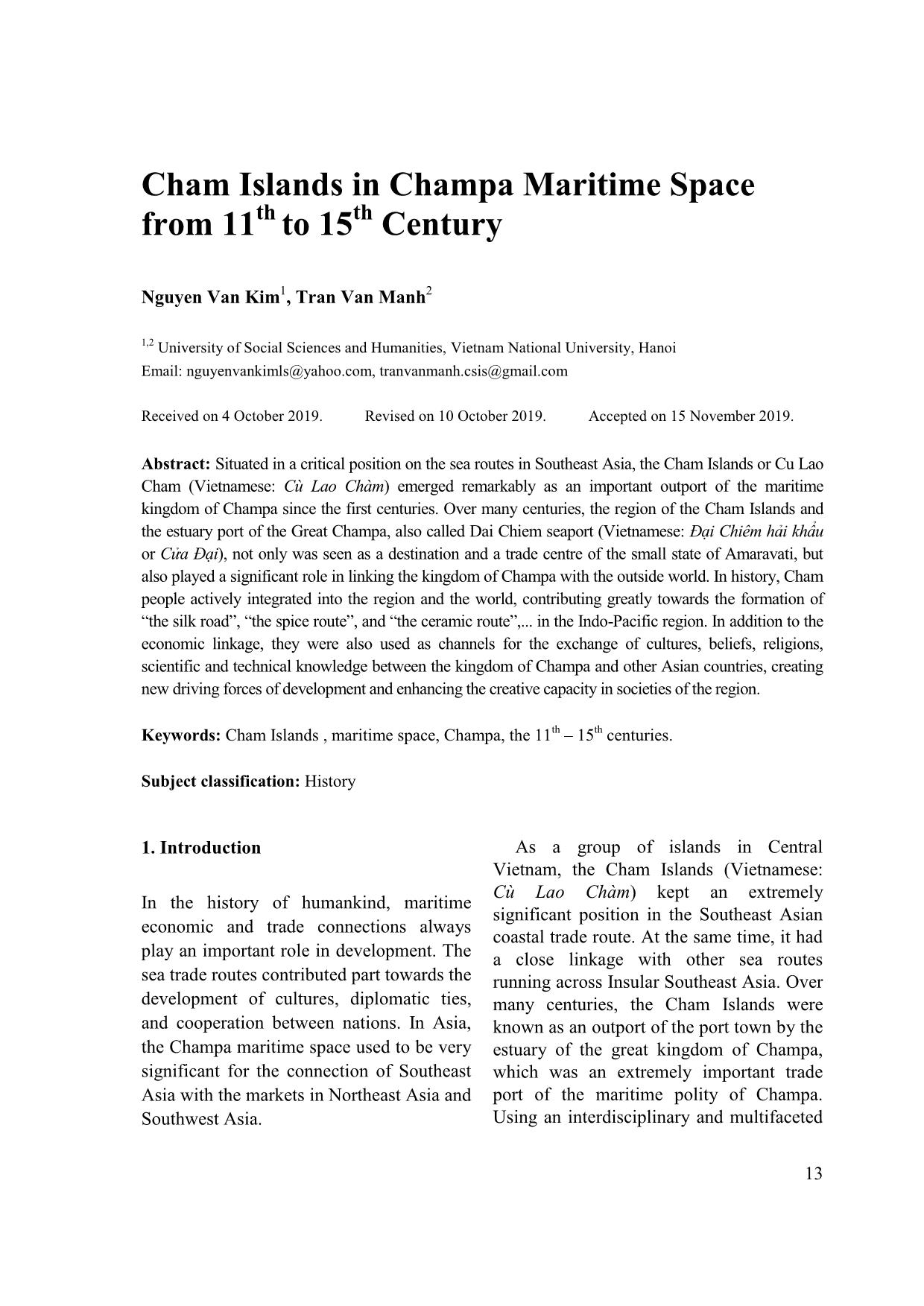
Trang 1
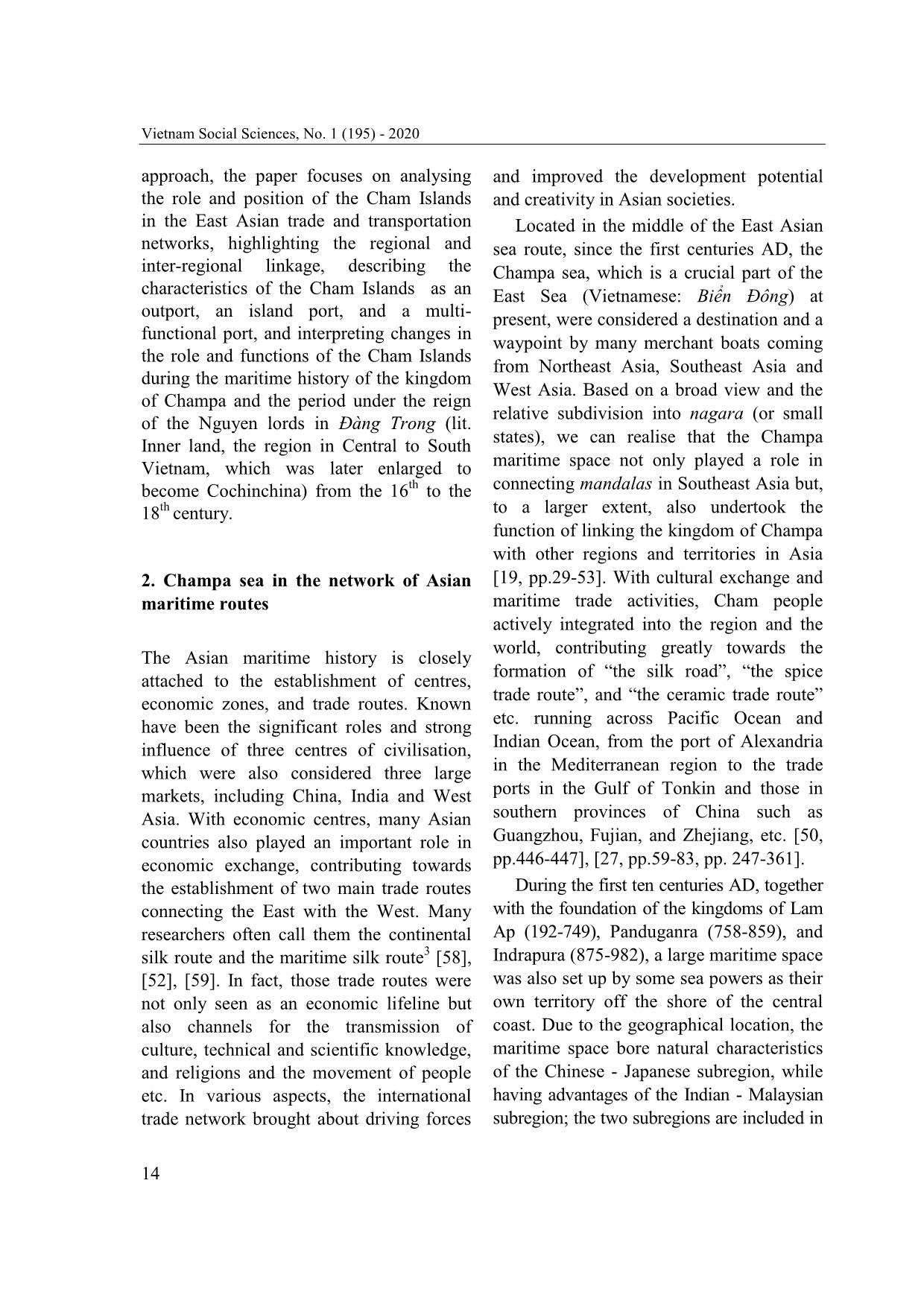
Trang 2
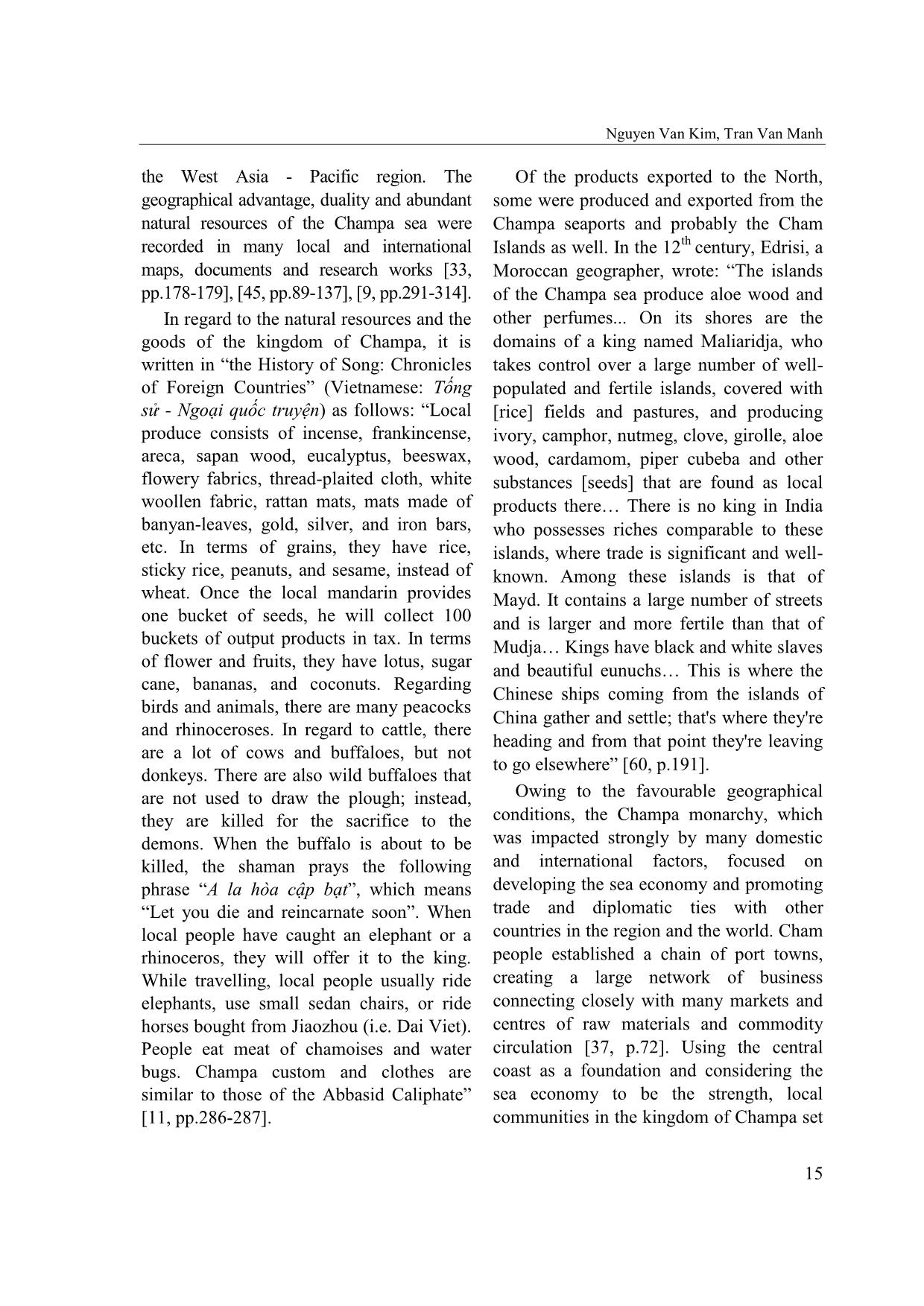
Trang 3
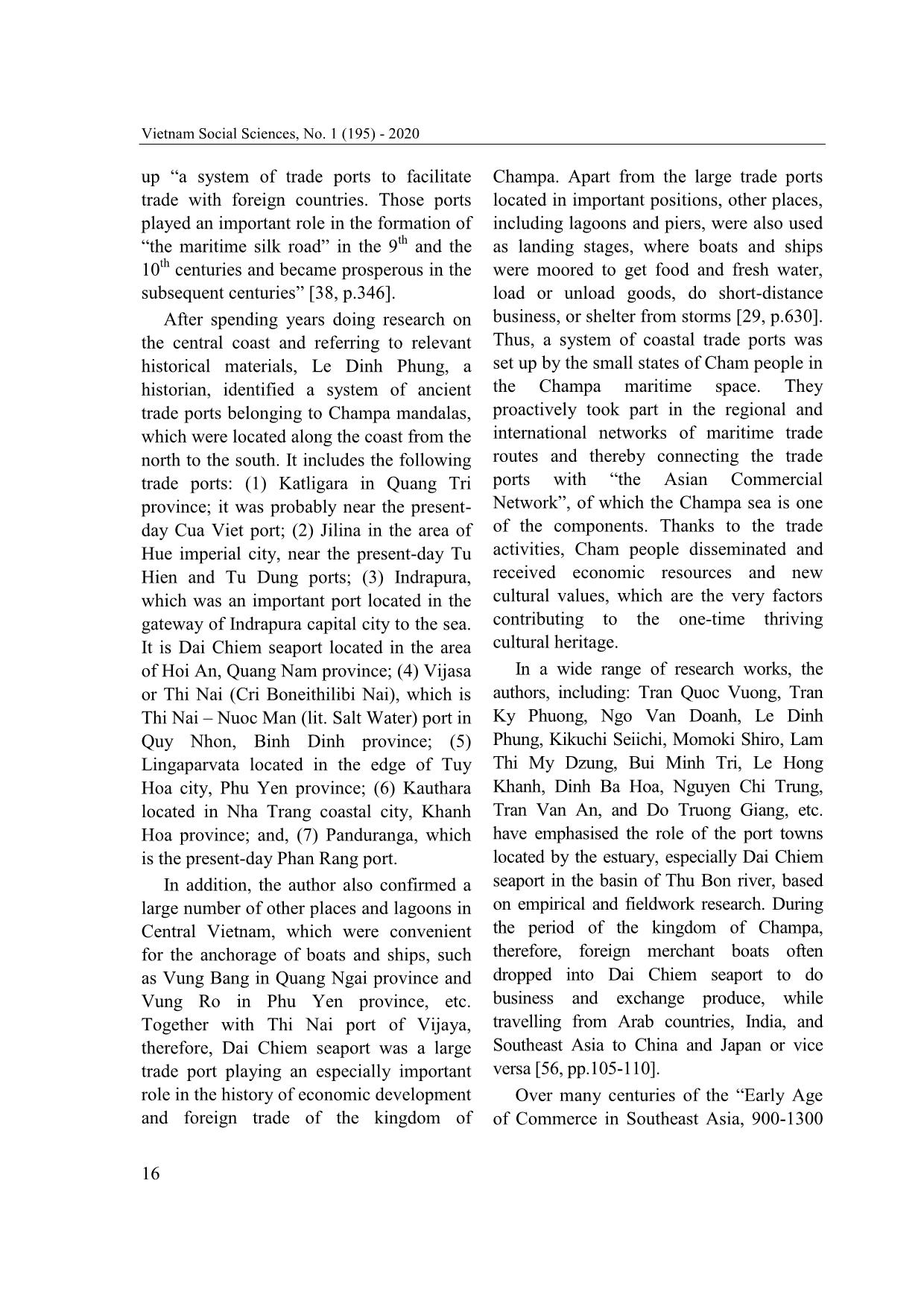
Trang 4
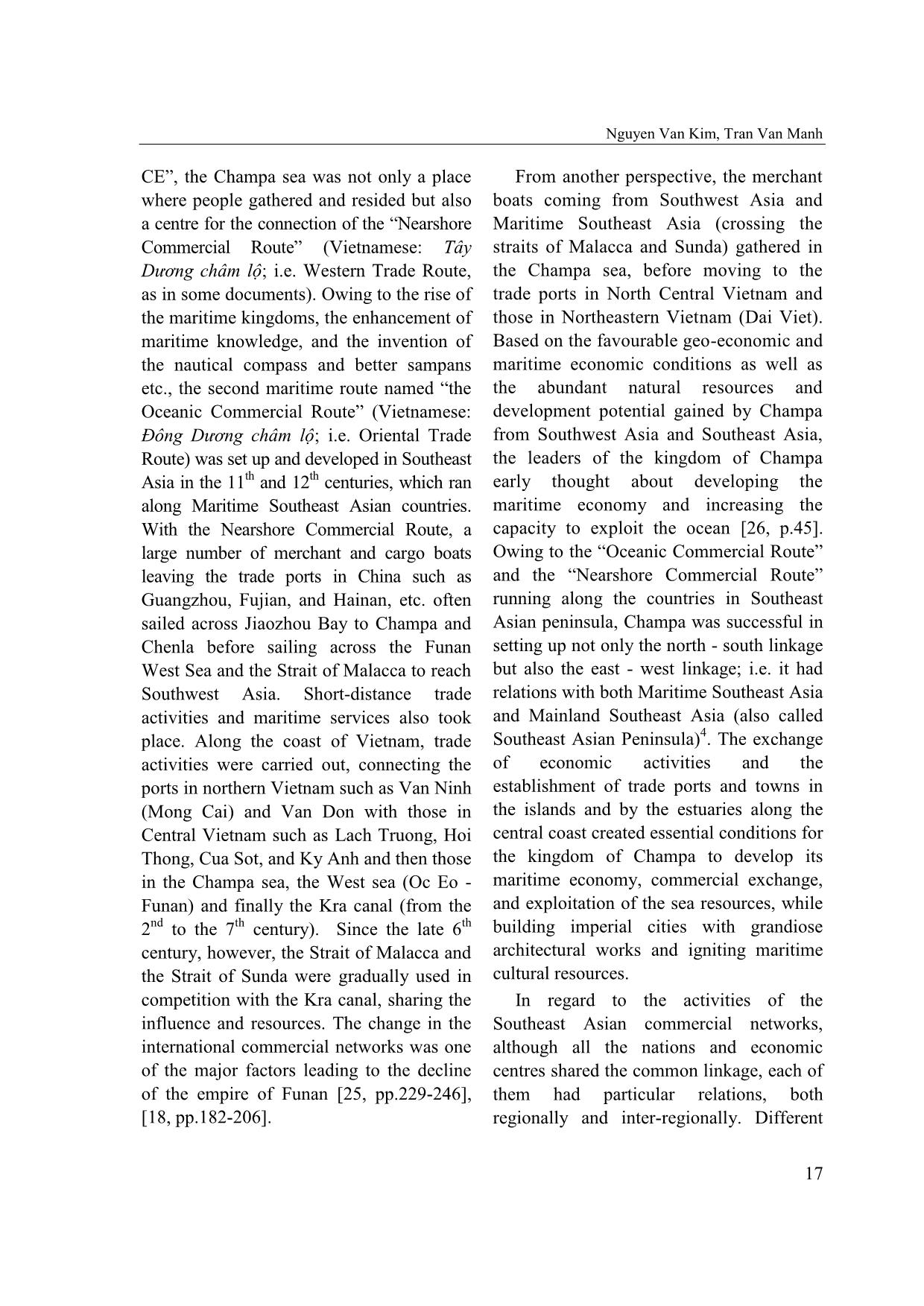
Trang 5
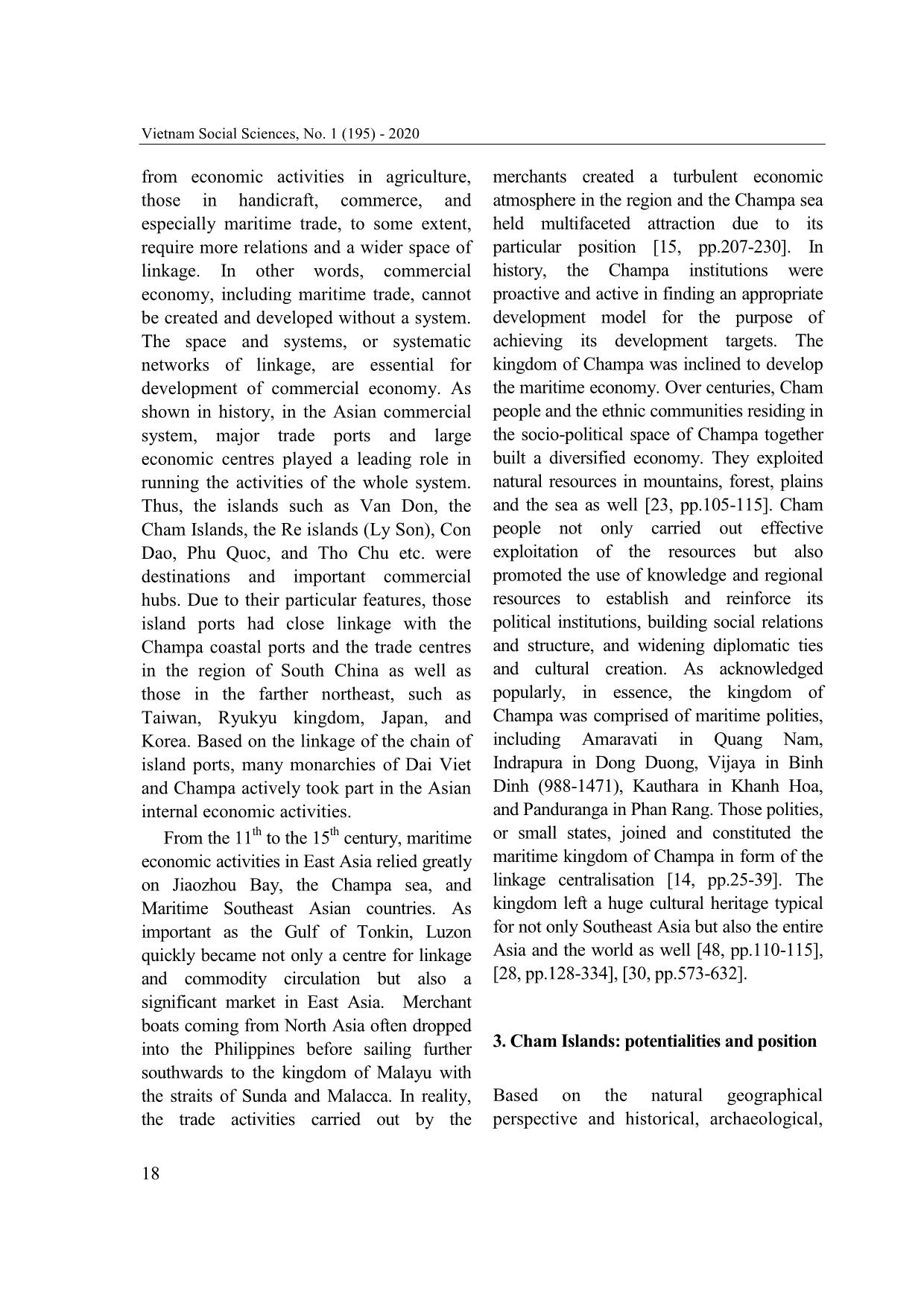
Trang 6
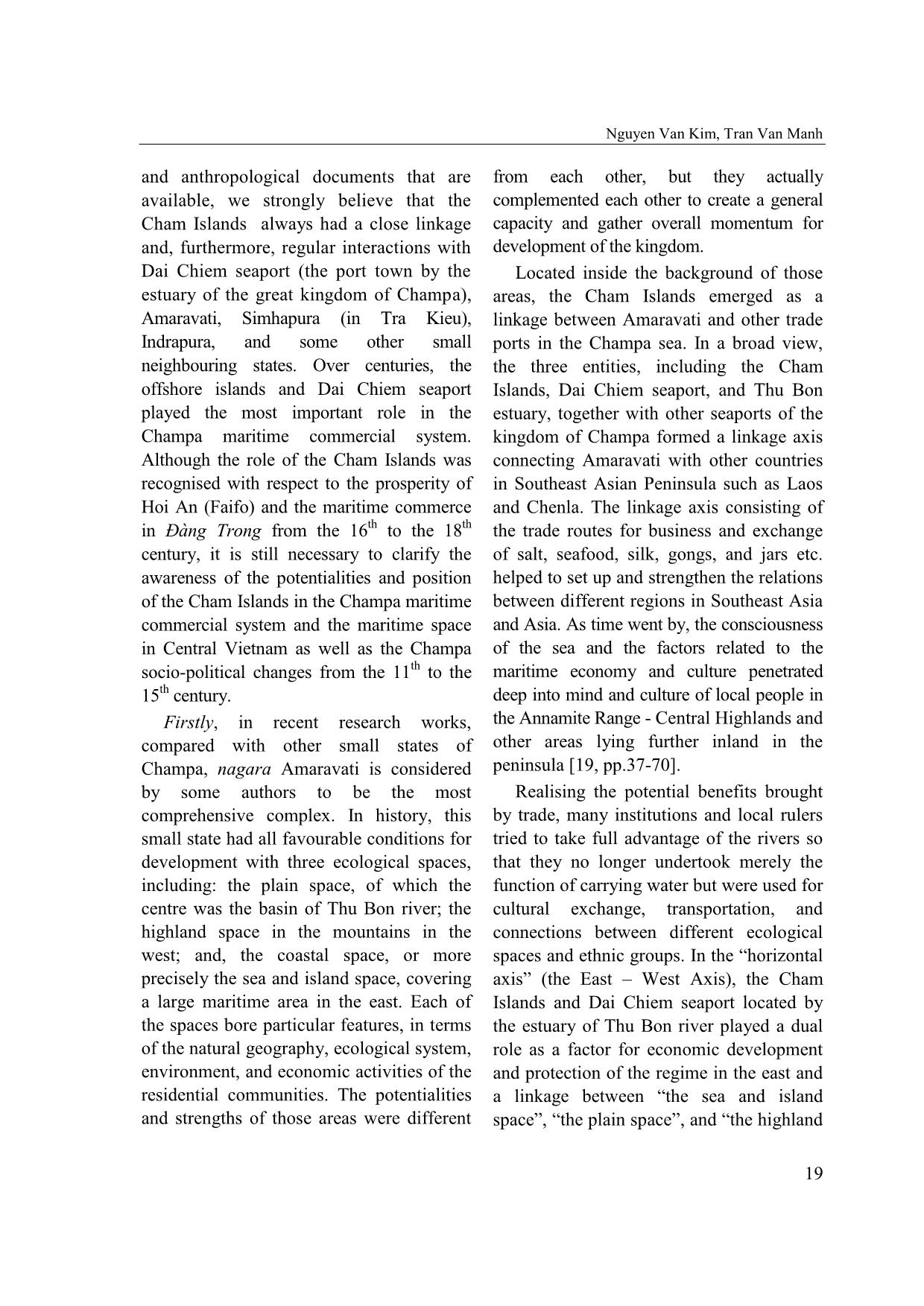
Trang 7
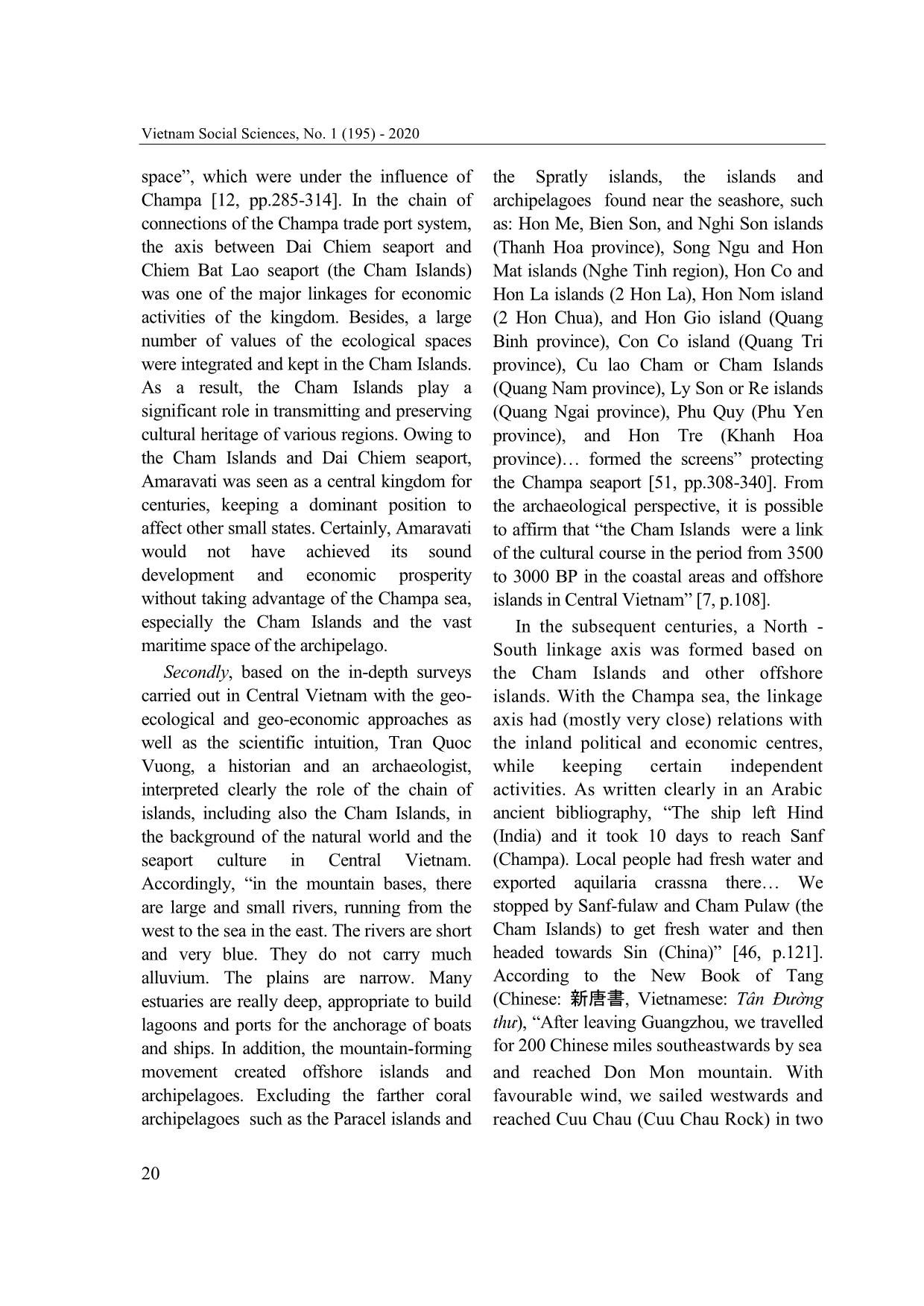
Trang 8

Trang 9
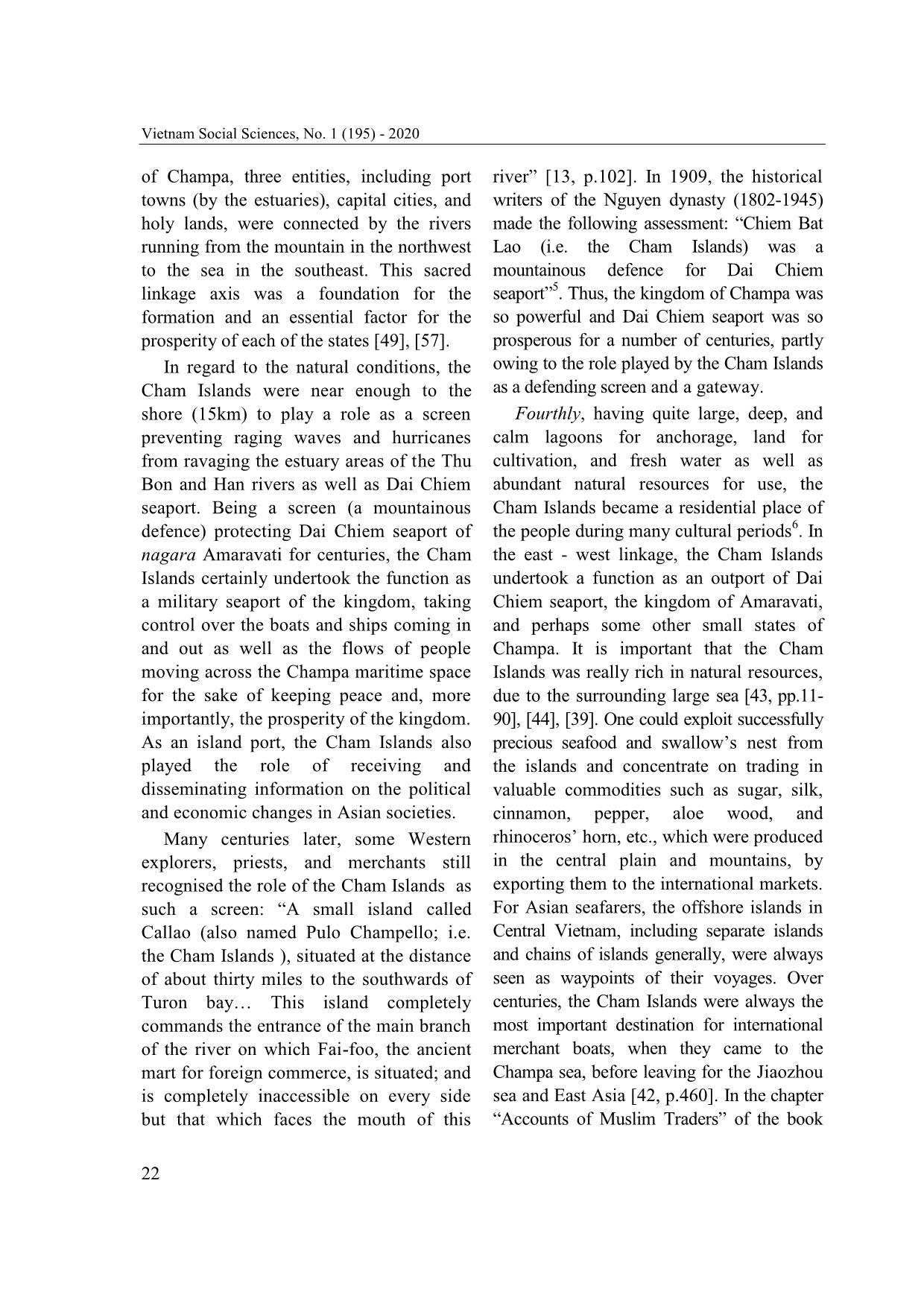
Trang 10
Tải về để xem bản đầy đủ
Tóm tắt nội dung tài liệu: Cham islands in Champa maritime space from 11th to 15th century
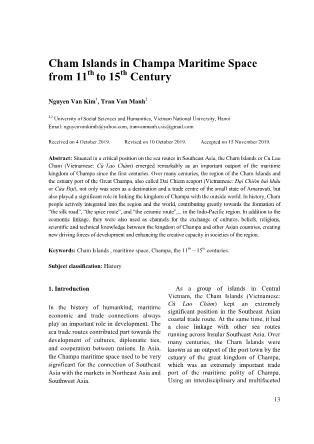
Prospects, Hoi An]. (1792-1793), Thế Giới Publishers, Hanoi]. [8] Lâm Thị Mỹ Dung (2017), Sa Huỳnh - Lâm Ấp - [2] Cristophoro Borri (1998), Xứ Đàng Trong năm Chămpa thế kỷ V TCN đến thế kỷ V SCN (Một số 1621, Nxb Tp. Hồ Chí Minh, Tp. Hồ Chí Minh. vấn đề Khảo cổ học), Nxb Thế Giới, Hà Nội. [Cristophoro Borri (1998), Cochinchina in [Lam Thi My Dzung (2017), Sa Huynh, Lam Ap, 1621, Ho Chi Minh City Publishing House, Ho and Champa from Fifth Century BC to Fifth Chi Minh City]. Century AD (Some Archaeological Issues), Thế [3] Nguyễn Đình Chiến (2017), “Đồ gốm sứ trong Giới Publishers, Hanoi]. 6 con tàu đắm ở vùng biển Việt Nam”, Khảo cổ [9] Lâm Thị Mỹ Dung, Đặng Hồng Sơn (Chủ biên) học Biển đảo Việt Nam: Tiềm năng và triển (2017), Khảo cổ học Biển đảo Việt Nam - Tiềm vọng, Nxb Đại học Quốc gia Hà Nội, Hà Nội. năng và triển vọng, Nxb Đại học Quốc gia Hà [Nguyen Dinh Chien (2017), “Ceramics in Six Nội, Hà Nội. [Lam Thi My Dzung, Dang Hong Shipwrecks in Sea of Vietnam”, Maritime and Son (chief authors) (2017), Maritime and 26 Nguyen Van Kim, Tran Van Manh Island Archaeology in Vietnam: Potentialities [15] Nguyễn Văn Kim (Chủ biên) (2011), Người and Prospects, Vietnam National University Việt với Biển, Nxb Thế Giới, Hà Nội. [Nguyen Press, Hanoi]. Van Kim (chief author) (2011), Viet People [10] Lê Quý Đôn (1977), Phủ biên tạp lục, Nxb and the Sea, Thế Giới Publishers, Hanoi]. Khoa học Xã hội, Hà Nội. [Le Quy Don [16 ] Nguyễn Văn Kim (2016), Vân Đồn - Thương (1977), Miscellaneous Chronicles of Pacified cảng quốc tế của Việt Nam, Nxb Đại học Quốc Frontier, Social Sciences Publishing House, gia Hà Nội, Hà Nội. [Nguyen Van Kim (2016), Hanoi]. Van Don - Vietnam’s International Trade Port, [11] Châu Hải Đường (dịch & biên soạn) (2018), Vietnam National University Press, Hanoi]. An Nam truyện - Ghi chép về Việt Nam trong [17] Nguyễn Văn Kim (2019), “Biển Việt Nam chính sử Trung Quốc xưa, Nxb Hội Nhà văn, trong các không gian biển Đông Nam Á”, Biển Hà Nội. [Chau Hai Duong (translated and Việt Nam và các mối giao thương biển, Nxb compiled) (2018), An Nam Stories: Records Đại học Quốc gia Hà Nội, Hà Nội. [Nguyen about Vietnam in Past Historical Documents Van Kim (2019), “Vietnam's Sea in Southeast of China, Vietnam Writers’ Association Asian Maritime Space”, Vietnam's Sea and Publishing House, Hanoi]. Maritime Trade Connections, Vietnam National [12] Đỗ Trường Giang (2011), “Biển với lục địa - University Press, Hanoi]. Thương cảng Thị Nại (Champa) trong hệ [18] Nguyễn Văn Kim (2019), “Óc Eo - Phù Nam: thống thương mại Đông Á thế kỷ X - XV”, Vị thế lịch sử và các mối quan hệ khu vực”, Người Việt với Biển, Nxb Thế Giới, Hà Nội. Biển Việt Nam và các mối giao thương biển, [Do Truong Giang, “Sea and Mainland: Thi Nxb Đại học Quốc gia Hà Nội, Hà Nội. Nai Trade Port (Champa) in East Asian [Nguyen Van Kim (2019), “Oc Eo - Funan: Commercial System from 10th to 15th Historical Position and Regional Connections”, Century”, Viet People and the Sea, Thế Giới Vietnam's Sea and Maritime Trade Connections, Publishers, Hanoi]. Vietnam National University Press, Hanoi]. [13] Arlo Griffiths, Amandine Lepoutre, William A. [19] Nguyễn Văn Kim (2019), “Biển trong sử thi Southworth & Thành Phần (2012), Văn khắc Đăm Di”, Nghiên cứu Văn hóa Miền Trung Chămpa tại Bảo tàng điêu khắc Chăm - Đà 2018, Nxb Đại học Huế, Huế. [Nguyen Van Nẵng, Nxb Đại học Quốc gia Tp. Hồ Chí Minh, Kim (2019), “Sea in Dam Di Epic”, Research Tp. Hồ Chí Minh. [Arlo Griffiths, Amandine on Culture in Central Vietnam 2018, Hue Lepoutre, William A. Southworth & Thanh University Publishing House, Hue]. Phan (2012), The Inscriptions of Campā at the [20] Nguyễn Văn Kim, Nguyễn Mạnh Dũng (Chủ Museum of Cham Sculpture in Da Nang, biên) (2015), Việt Nam - Truyền thống kinh tế, Vietnam National University Press, Ho Chi văn hóa biển, Nxb Chính trị Quốc gia - Sự thật, Minh City]. Hà Nội. [Nguyen Van Kim, Nguyen Manh Dung [14] Nguyễn Văn Kim (2008), “Dấu ấn cổ sơ của các (chief authors) (2015), Vietnam: Economic and xã hội Đông Nam Á”, Tạp chí Nghiên cứu Lịch Maritime Cultural Tradition, National Political sử, số 6 (386). [Nguyen Van Kim (2008), “Traces Publishing House, Hanoi]. of Southeast Asian Primeval Societies”, Journal [21] Nguyễn Văn Kim, Đỗ Trường Giang (2017), of Historical Studies, No. 6 (386)]. “Nghiên cứu lịch sử, văn hóa Chămpa - Một 27 Vietnam Social Sciences, No. 1 (195) - 2020 số suy nghĩ và vấn đề đặt ra”, Nam Trung Bộ [27] Nguyễn Quang Ngọc, Nguyễn Văn Kim (Chủ và Nam Bộ trong lịch sử Việt Nam, Nxb Thế biên) (2018), Biển với lục địa - Vai trò và Giới, Hà Nội. [Nguyen Van Kim, Do Truong mạng lưới giao lưu ở lưu vực các dòng sông Giang (2017), “Research on Champa History miền Trung, Nxb Đại học Quốc gia Hà Nội, and Culture: A Number of Considerations and Hà Nội. [Nguyen Quang Ngoc, Nguyen Van Issues”, South Central Vietnam and Kim (chief authors) (2018), Sea and Cochinchina in History of Vietnam, Thế Giới Mainland: Role and Exchanging Networks in Publishers, Hanoi]. Basins of Rivers in Central Vietnam, Vietnam [22] Seiichi Kikuchi (2010), Nghiên cứu Đô thị cổ National University Press, Hanoi]. Hội An, Nxb Thế Giới, Hà Nội. [Kikuchi [28] Lương Ninh (2015), Một con đường sử học, Seiichi (2010), Research on Ancient Town of Nxb Đại học Sư phạm, Hà Nội. [Luong Ninh Hoi An, Thế Giới Publishers, Hanoi]. (2015), A Path of Historical Studies, Hanoi [23] Pièrre-Bernard Lafont (2011), Vương quốc National University of Education Publishing Chămpa - Địa dư, Dân cư và Lịch sử, House, Hanoi]. International Office of Champa, California, USA. [29] Lê Đình Phụng (1997), “Thương cảng Chămpa [Pièrre-Bernard Lafont (2011), The Kingdom of trong lịch sử”, Những phát hiện mới về Khảo Champa: Geography - Population - History, cổ học năm 1996, Nxb Khoa học Xã hội, Hà International Office of Champa, California, USA]. Nội. [Le Dinh Phung (1997), “Champa Trade [24] Phan Huy Lê (2006), “Tưởng nhớ công lao của Ports in History”, New Archaeological Findings in vua Trần Nhân Tông và công chúa Huyền 1996, Social Sciences Publishing House, Hanoi]. Trân”, Tạp chí Xưa và Nay, số 263. [Phan Huy [30] Lê Đình Phụng (2017), Khảo cổ học Chămpa - Le (2006), “In Memory of Contributions of Khai quật và phát hiện, Nxb Khoa học Xã hội, King Tran Nhan Tong and Princess Huyen Hà Nội. [Le Dinh Phung (2017), Champa Tran”, Review “Past and Present”, No. 263]. Archaeology: Excavations and Findings, [25] Phan Huy Lê (2008), “Thử nhận diện nước Phù Social Sciences Publishing House, Hanoi]. Nam qua tư liệu thư tịch và khảo cổ học”, Văn [31] Phạm Quốc Quân (2000), “Kết quả khai quật hóa Óc Eo & Vương quốc Phù Nam, Nxb Thế tàu cổ đắm ở vùng Cù Lao Chàm (1997- Giới, Hà Nội. [Phan Huy Le (2008), “An 2000)”, Tạp chí Xưa & Nay, số 76. [Pham Attempt to Identify Funan State, based on Quoc Quan (2000), “Findings of Excavations Bibliographical and Archaeological Documents”, of Ancient Shipwreck in Cham Islands (1997- Oc Eo Culture and Kingdom of Funan, Thế Giới 2000)”, Review “Past and Present”, No. 76]. Publishers, Hanoi]. [32] Phạm Hoàng Quân (2011), “Những ghi chép [26] Momoki Shiro (1999), “Chămpa chỉ là một thể liên quan đến Biển Đông Việt Nam trong chính chế biển? (Những nghi chép về nông nghiệp và sử Trung Quốc”, Tạp chí Nghiên cứu và Phát ngành nghề trong các tư liệu Trung Quốc)”, triển, số 1. [Pham Hoang Quan (2011), Tạp chí Nghiên cứu Đông Nam Á, số 4. “Records Related to Vietnam’s East Sea in [Momoki Shiro (1999), “Was Champa only a Chinese Historical Documents”, Review Maritime Polity? (Agricultural and Professional “Research and Development”, No. 1]. Records in Chinese Documents)”, Journal of [33] Phạm Hoàng Quân (2016), Tập bản đồ hàng Southeast Asian Studies, No. 4]. hải 1841 ở Thư viện Đại học Yale, Nxb Văn 28 Nguyen Van Kim, Tran Van Manh hóa - Văn nghệ, Hà Nội. [Pham Hoang Quan “Champa - Binh Dinh Terracotta: Production (2016), Yale University Navigational Map Book Relics in Context of Asian Maritime Trade”, 1841, Culture, Literature and Arts Publishing Ancient Imperial Cities in Vietnam, Social House, Hanoi]. Sciences Publishing House, Hanoi]. [34] Quốc sử quán triều Nguyễn (1856-1881) [41] Nguyễn Chí Trung (2007), “Tổng quan về (2006), Đại Nam nhất thống chí, t.2, Nxb Khảo cổ - Lịch sử Cù Lao Chàm”, Cù Lao Thuận Hóa, Huế. [National Bureau of History Chàm: Vị thế, tiềm năng và triển vọng, Hội An. under the Nguyen Dynasty (1856-1881) (2006), [Nguyen Chi Trung (2007), “Archaeological Dai Nam Comprehensive Encyclopaedia, Vol. and Historical Overview of Cham Islands”, 2, Thuan Hoa Publishing House, Hue]. Cham Islands: Position, Potentialities and [35] Yumio Sakurai (1996) (Vũ Minh Giang biên Prospects, Hoi An]. dịch), “Thử phác dựng cấu trúc lịch sử của khu [42] Nguyễn Chí Trung (2018), “Vai trò của hệ vực Đông Nam Á (Thông qua mối quan hệ thống sông và cửa biển đối với sự hình thành giữa biển và lục địa)”, Tạp chí Nghiên cứu và phát triển của đô thị thương cảng Hội An”, Đông Nam Á, số 4. [Sakurai Yumio (1996) Biển với lục địa - Vai trò và mạng lưới giao (translated by Vu Minh Giang), “An Outline of lưu ở lưu vực các dòng sông miền Trung, Nxb South East Asia History Structure through the Đại học Quốc gia Hà Nội, Hà Nội. [Nguyen Connection between the Sea and the Land”, Chi Trung (2018), “Roles of System of Rivers Journal of Southeast Asian Studies, No. 4]. and Seaports in Formation and Development of [36] Thích Đại Sán (2015), Hải ngoại kỷ sự, Nxb Hoi An Trade Port”, Sea and Mainland: Role Đại học Sư phạm, Hà Nội. [Thich Dai San and Exchanging Networks in Basins of Rivers (2015), Overseas Historical Events, Hanoi in Central Vietnam, Vietnam National University National University of Education Publishing Press, Hanoi]. House, Hanoi]. [37] Lê Tắc (2002), An Nam chí lược, Nxb Thuận [43] Trung tâm Quản lý Bảo tồn Di tích Hội An Hóa - Trung tâm Văn hóa Ngôn ngữ Đông Tây, (2007), Cù Lao Chàm - Vị thế, tiềm năng và Huế. [Le Tac (2002), Abbreviated Records of An triển vọng, Hội An. [Hoi An Centre for Vestige Nam, Thuan Hoa Publishing House, Centre for Preservation and Management (2007), Cham Western and Eastern Culture and Language, Hue]. Islands: Position, Potentialities and Prospects, [38] Hà Văn Tấn (Chủ biên) (2002), Khảo cổ học Hoi An]. Việt Nam, t.3, Nxb Khoa học Xã hội, Hà Nội. [44] Trung tâm Quản lý Bảo tồn Di sản văn hóa Hội [Ha Van Tan (chief author) (2002), Vietnamese An (2014), Thông tin Nghiên cứu Cù Lao Archaeology, Vol. 3, Social Sciences Publishing Chàm, Hội An. [Hoi An Centre for Cultural House, Hanoi]. Heritage Preservation (2014), Cham Islands [39] Thông tin Nghiên cứu Địa lý - Sinh thái Hội An, Research Information, Hoi An]. Hội An, 2016. [Hoi An Geographical and [45] Trường Đại học Khoa học xã hội và Nhân văn, Ecological Research Information, Hoi An, 2016]. Đại học Quốc gia Hà Nội, (2007), Việt Nam [40] Bùi Minh Trí (2019), “Gốm Chămpa - Bình trong hệ thống thương mại châu Á thế kỷ XVI- Định: Di chỉ sản xuất trong bối cảnh thương mại XVII, Nxb Thế Giới, Hà Nội. [University of biển Châu Á”, Kinh thành cổ Việt Nam, Nxb Social Sciences and Humanities, Vietnam Khoa học Xã hội, Hà Nội. [Bui Minh Tri (2019), National University Hanoi (2007), Vietnam in 29 Vietnam Social Sciences, No. 1 (195) - 2020 Asian Commercial System in 16th and 17th [51] Trần Quốc Vượng (1998), Việt Nam cái nhìn Centuries, Thế Giới Publishers, Hanoi]. địa - văn hóa, Nxb Văn hóa Dân tộc, Hà Nội. [46] Hoàng Anh Tuấn (2007), “Cù Lao Chàm và [Tran Quoc Vuong (1998), Vietnam: A Geo- hoạt động thương mại ở Biển Đông thời Cultural View, Ethnic Cultures Publishing vương quốc Chămpa”, Cù Lao Chàm - Vị House, Hanoi]. thế, tiềm năng và triển vọng, Hội An. [52] Andre Gunder Frank (1998), Re-Orient - Global [Hoang Anh Tuan (2007), “Cham Islands Economy in the Asian Age, University of and Trade Activities in East Sea during the California Press. Period of the Kingdom of Champa”, Cham [53] Kenneth R. Hall (1985), Maritime Trade and State Islands : Position, Potentialities and Prospects, Development in Early Southeast Asia, University Hoi An]. of Hawaii Press. [47] Hoàng Anh Tuấn, Đỗ Trường Giang (2017), [54] Georges Maspéro (2002), Champa Kingdom - “Hội An trong mạng lưới thương mại biển Á The History of an Extinct Vietnamese Culture, Châu (thế kỷ 7-13)”, Khảo cổ học Biển đảo Bangkok, White Lotus Press. Việt Nam, Nxb Đại học Quốc gia Hà Nội, Hà [55] Takashi Suzuki (2019), The History of Nội. [Hoang Anh Tuan, Do Truong Giang Srivijaya, Angkor and Champa, Mekong (2017), “Hoi An in Asian Maritime Commercial Publishing Co., Ltd. Networks (from 7th to 13th Century”, Maritime [56] Tran Ky Phuong, Vu Huu Minh (1991), Port of and Island Archaeology in Vietnam, Vietnam Great Champa in the 4th–15th Centuries, in National University Press, Hanoi]. “Ancient Town of Hoi An”, National Committee [48] Viện Nghiên cứu Kinh thành, Viện Hàn lâm for International Symposium on Ancient Town of Khoa học xã hội Việt Nam (2019), Kinh thành Hoi An, Thế Giới Publishers. cổ Việt Nam, Nxb Khoa học Xã hội, Hà Nội. [57] Tran Quoc Vuong (1998), Vietnam - A Geo- [Institute of Imperial City Research, Vietnam Cultural View, National Culture Publishers, Hanoi. Academy of Social Sciences (2019), Ancient Imperial Cities in Vietnam, Social Sciences [58] Elisseeff Vadime (2000), The Silk Roads - Publishing House, Hanoi]. Highways of Culture and Commerce, [49] Trần Quốc Vượng (1995), “Miền Trung Việt UNESCO Publishing. Nam và văn hóa Chămpa”, Tạp chí Nghiên cứu [59] Charles James Wheeler (2001), Cross-cultural Đông Nam Á, số 4 (21). [Tran Quoc Vuong Trade and Trans-regional Networks in the Port (1995), “Central Vietnam and Champa Culture”, of Hoi An: Maritime Vietnam in Early Modern Journal of Southeast Asian Studies, No. 4 (21)]. Era, Ph.D. Dissertation, Yale University. [50] Trần Quốc Vượng (1996), “Vài suy nghĩ về [60] Robert S. Wicks (1992), “Money, Markets, and văn hóa Quảng Trị cổ”, Theo dòng lịch sử - Trade in Early Southeast Asia - The Development Những vùng đất, thần và tâm thức người Việt, of Indigenous Monetary Systems to AD 1400”, Nxb Văn hóa, Hà Nội. [Tran Quoc Vuong Studies on Southeast Asia, Southeast Asia (1996), “Some Comments on Ancient Culture Program, Cornell University, New York. in Quang Tri”, With the Course of Time: [61] Ferrand Gabriel (1913-14), Relations de Lands, Mind, and Consciousness of Vietnamese voyages et texts rélatifs à l’Extrême Orient, 2 People, Cultural Publishing House, Hanoi]. Vols, Paris: Leroux. 30
File đính kèm:
 cham_islands_in_champa_maritime_space_from_11th_to_15th_cent.pdf
cham_islands_in_champa_maritime_space_from_11th_to_15th_cent.pdf

